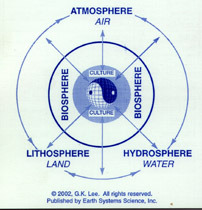Earth Systems Science, Inc.
The Geographic Systems Model

Basic Geographic Concepts
The Geographic Systems Model has three basic Geographic concepts: Location, Scale, and Time.
Location tells you where you are in the world. Another word for location is place. Each place in the world is unique (different in a special way) from any other place in the world. It is unique due to the combination of the elements of the various environmental spheres (see next section of this paper).
Scale tells you the physical size of the location or the level of detail of the study. A neighborhood is an example of a "local" scale. A neighborhood is found in a city. A city or a state is considered a "regional" scale. The global scale deals with the entire world. [Note: It is important to use the same scale when examining the different environmental spheres to characterize a place and when comparing and contrasting one place to another.]
Time is the sequential measurement of events. A neighborhood gets started by some people living in a place. After a while, it has a "past" (history), a "present" (now, today), and a "future" (tomorrow or further ahead). The same neighborhood can appear quite different from one season to another. [Note: It is important to use the same time period when examining the different environmental spheres to characterize a place and when comparing and contrasting one place to another.]
The Environmental Spheres
A simple way to see the world is to use the four environmental spheres: Atmosphere, Biosphere, Hydrosphere, and Lithosphere. They can be classified as “living” (the Biosphere) and “non-living” (the Atmosphere, Hydrosphere, and Lithosphere). They can also be reclassified on the basis of the dominant forms of matter found in their basic constitution.
The Atmosphere is a non-living mixture of gases (with some solid and liquid particles) surrounding the Earth. Weather is the present condition of the atmosphere for a place. Climate is a historical summary of past weather for that place.
The Biosphere contains all the living organisms (made up of various combinations of solids, liquids, and gases) found at a place. This includes all the plants, animals, and people. People have culture (their language, art, religion, science, philosophy, etc). They see the world and all living things around them through the “filter” of their culture. Different people have different cultures. Thus, different people can look at the same organism and "see" it very differently. One person sees it as a source of food. Another might see it as a pet.
The Hydrosphere is a non-living mixture of liquids (with some solid and gas particles) and includes all water on Earth. Water is very special. On Earth, it can be found as a solid (ice), liquid (water), or a gas (water vapor) under normal environmental temperatures and pressures.
The Lithosphere is a non-living mixture of solids (with some liquid and gas particles) and includes all the solid rock materials found at or near the surface of the Earth.
Processes and Actions: Natural Forces
There are natural processes that change materials from one form to another (solids, liquids, gases) or store them in natural systems. Some processes move the materials from one environmental sphere to another.
The General Systems Matrix helps to study the interactions of the Geographic Systems Model. The key components of the Matrix are Inputs (which are either Matter or Energy), Processes (that either alter or store the inputs), Outputs (which due to the basic Laws of Conservation of Matter and Energy, are forms of Matter or Energy), and Feedback (Outputs from one system become inputs to the same system or another system).
Yin-Yang is incorporated into the Geographic Systems Model as a non-linear, non-Aristotlean model to supplement studying the balance of universal forces. It is also part of the ESSI commitment to cultural diversity through the inclusion of other points of view.
The combination of all these environmental spheres, materials, and processes at a given place and time help to make each place unique.
[Note: The Geographic Systems Model is fully presented in ESSI Publication #GA-0208-1, "Student Survival Guide for Physical Geography, 5th Edition" for $16 (Older editions available for $12) postpaid (Continental US addresses only). Make checks or money orders payable to Earth Systems Science, Inc., PO Box 8042, Van Nuys, CA 91409-8042. All proceeds go to fund ESSI community-based environmental education projects.]
This page last updated: 26 Feb 2005.
© 2002, revised 2005, Earth Systems Science, Inc. All rights reserved.
Email us
earthsystemsscience@yahoo.com
